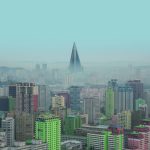VIETNAM TRAVEL GUIDE 2024: NOI BAI INTERNATIONAL AIRPORT IN HANOI
Noi Bai International Airport in Hanoi (Vietnamese Name: Sân Bay Quốc Tế Nội Bài or Cảng Hàng Không Quốc Tế Nội Bài) is the biggest international airport in the North of Vietnam, and second biggest of the country. This is serving the capital Hanoi and the surrounding area, replacing the old Gia Lam airport. Noi Bai Airport is the main hub for Vietnam Airlines, VietJet Air, Pacific Airlines, Bamboo Airways and formerly Indochina Airlines. The airport is also one of 3 busiest airports in Vietnam with Tan Son Nhat International Airport in Saigon and Da Nang international Airport in Central Vietnam.
- Location: Phu Minh Commune, Soc Son District, Hanoi City, Vietnam
- Noi Bai International Airport code:
- IATA (International Air Transport Association) code: HAN
- ICAO (International Civil Aviation Organization) code: VVNB
Where is Noi Bai Hanoi International Airport? It is located in Soc Son district, 35km from Hanoi Old Quarter and Hoan Kiem Lake (the center of Hanoi capital) by road to the northwest. This distance was shortened to 27km when Nhat Tan Bridge and the road connecting this bridgehead with Noi Bai were completed in 2015. In addition, it is also possible to follow Highway 3 leading from Chuong Duong bridge to the intersection with National Highway 2 to access the airport. Noi Bai International Airport is also located near cities in neighboring provinces such as Vinh Yen, Phuc Yen, Bac Ninh, Ninh Binh, Ha Lon and Hai Phong City
1. History of Noi Bai International Airport in Hanoi:
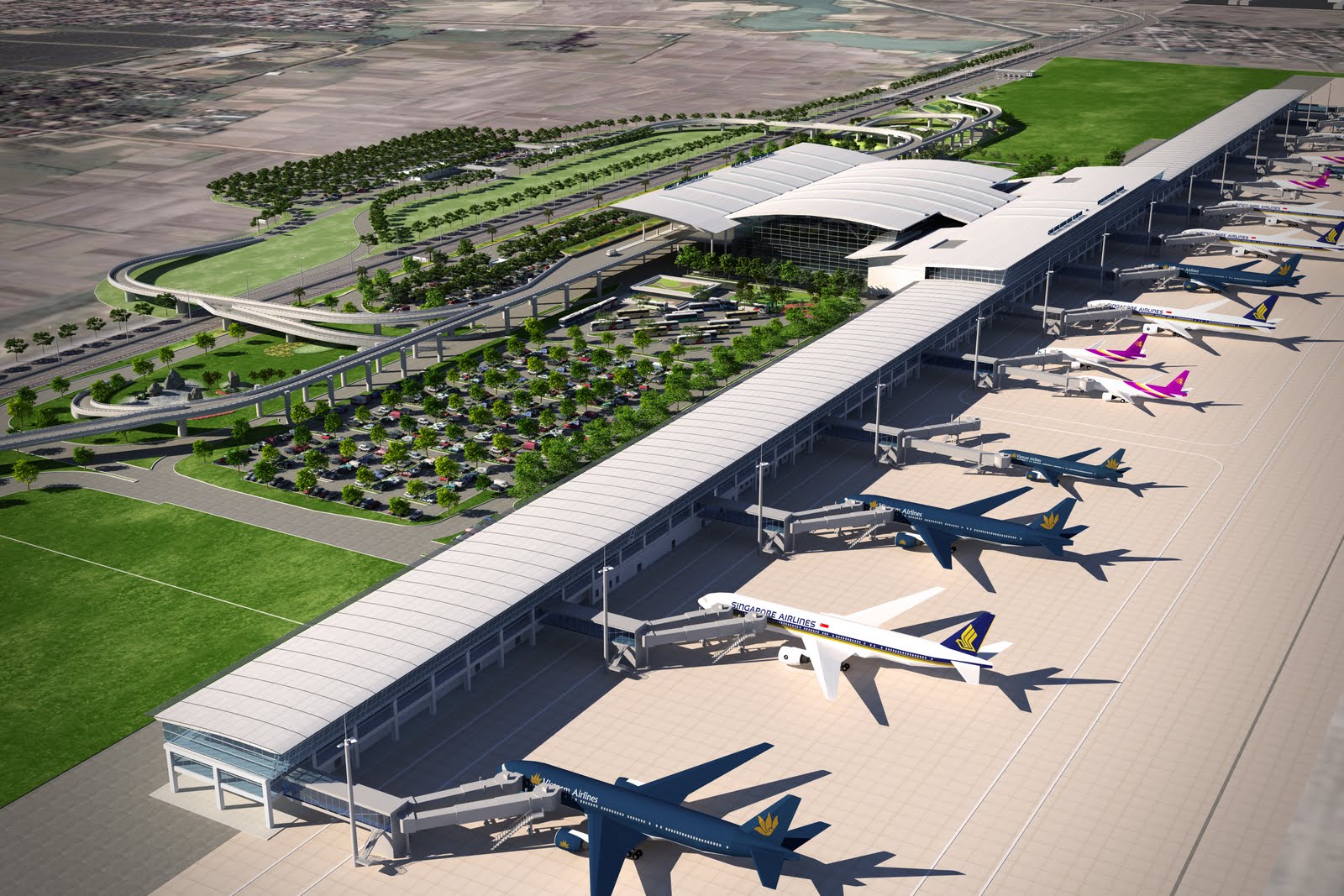
Noi Bai International Airport, formerly an air base of the Vietnam People’s Air Force during the Vietnam War, also known as Da Phuc Airport, has been renovated to serve both civilian and military purposes.
On February 28, 1977, the General Department of Civil Aviation of Vietnam issued a decision to establish Noi Bai International Airport in Soc Son district, Hanoi. On January 2, 1978, the airport officially opened for operation and welcomed the first international flight to land.
The airport is named after Noi Bai village, a village in Ninh Bac, Kim Anh district, Phuc Yen province before, because most of the airport land is located on this village. In 1995, the T1 passenger terminal was built and inaugurated in October 2001.
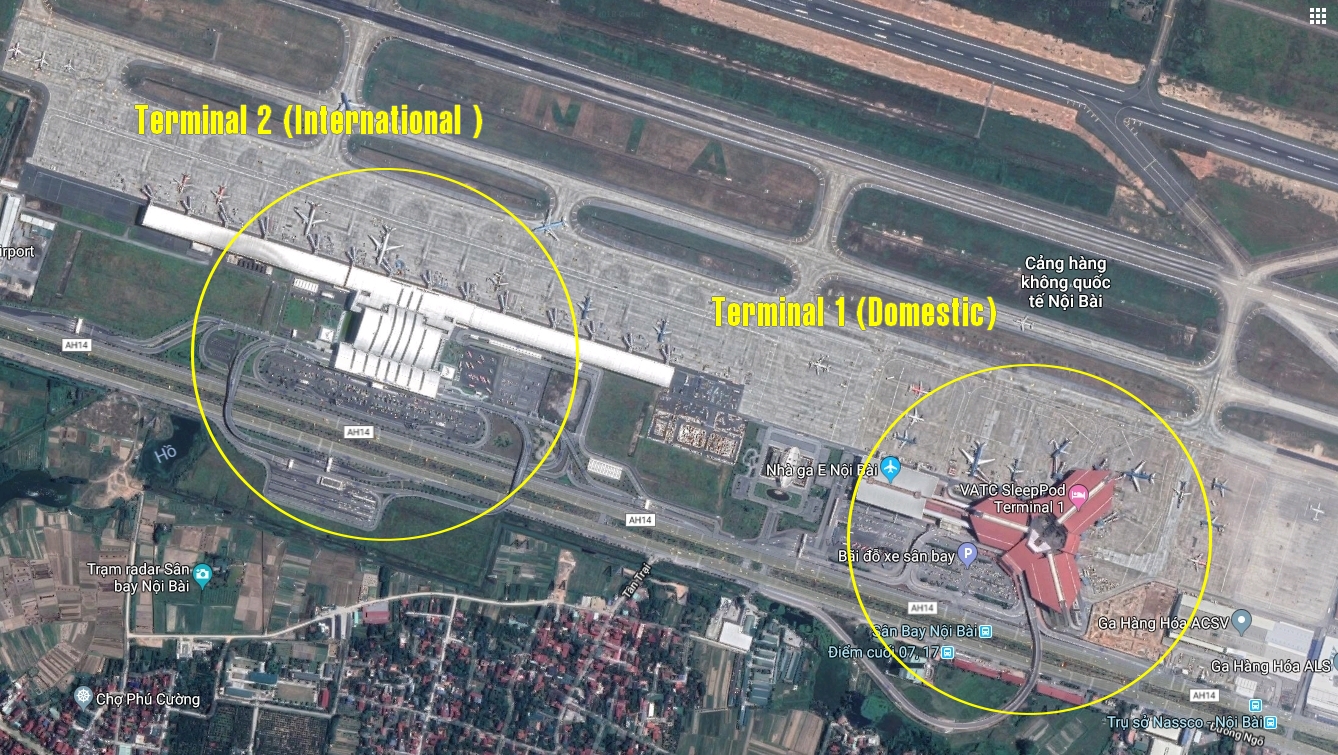
On December 29, 2013, Terminal T1 completed the construction of more Hall E and opened its doors, connecting with Hall A, helping the airport reduce passenger traffic.
On December 25, 2014, the VIP guest house and T2 terminal were inaugurated. Terminal T2 officially became a terminal serving international flights and the old terminal T1 was converted to serve domestic flights.
On January 4, 2015, T2 International Terminal was inaugurated at the same time as Nhat Tan Bridge. That helps to shorten the connencting route from Hanoi International Airport to the city center to 29km or 45 minutes driving.
2. Modern Infrastructure of Noi Bai International Airport:
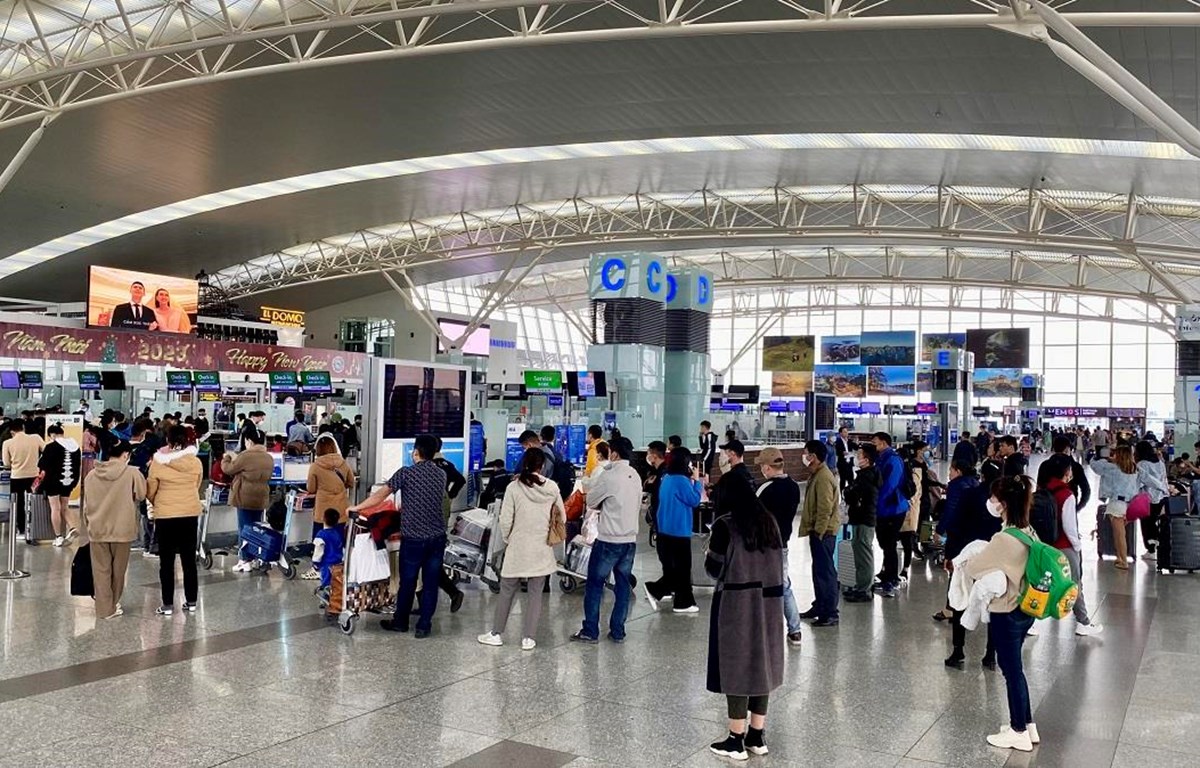
Noi Bai Airport not only caters to civil flights but also operates military ones. It has separate areas for the two, with the civil sector located in the south of the runway and the military in the north. It has well-developed infrastructure, providing passengers with a safe, comfortable, and efficient experience.
-
Terminals of Hanoi International Airport

The airport features two terminals, Terminal 1 for domestic flights and Terminal 2 for international flights, which are connected by a shuttle bus service. Both terminals are equipped with various modern facilities, including duty-free shops, restaurants, cafes, lounges, post offices, currency exchange services, and ATMs.
-
Runways of Hanoi International Airport

Noi Bai Airport boasts two parallel runways: 11L/29R and 11R/29L, which are situated 250 meters away from each other. This design allows for a safe and efficient flow of air traffic, as simultaneous takeoffs and landings are not permitted on the two runways.
- The 11L/29R runway, also referred to as 1A, is 3,200 meters long and 45 meters wide, offering ample space for aircraft to safely land and take off.
- The 11R/29L runway, or 1B, is even longer, with a length of 3,800 meters and a width of 45 meters.
This ensures that Noi Bai Airport is well equipped to handle a wide range of aircraft types and sizes, making it an essential hub for aviation in Vietnam.
3. Terminals of Noi Bai International Airport:
As mentioned above, Noi Bai International Airport Hanoi Vietnam consists of two terminals: Terminal 1 for domestic flights and Terminal 2 for international ones.
-
Noi Bai International Airport Terminal T1 for Domestic Departure
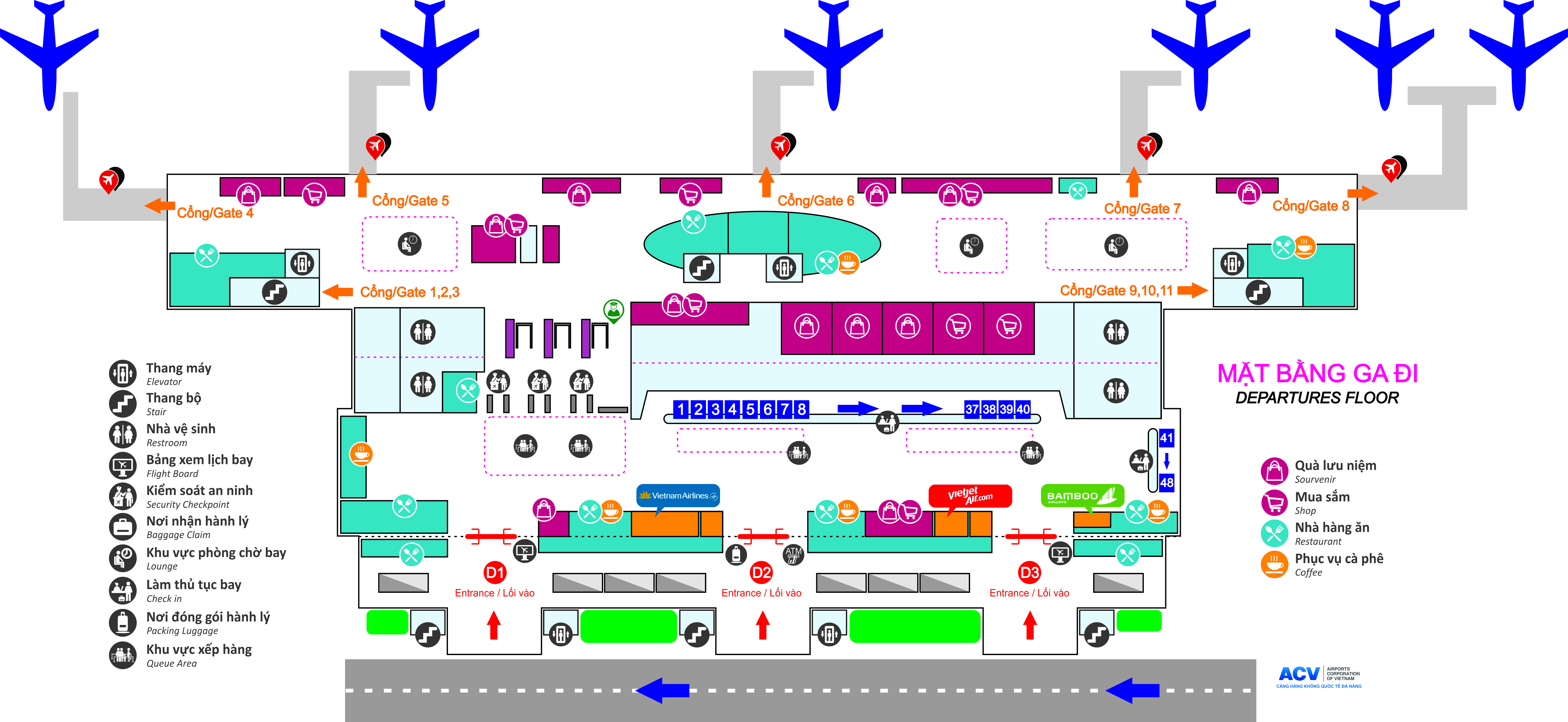
Terminal T1 at Noi Bai Airport is 115,000 square meters in size. It can accommodate up to 15 million passengers annually. It has four floors equipped with modern equipment and facilities for both air and ground services, including:
– First floor: Arrival and baggage claim areas
– Second floor: Check-in, baggage drop-off, and waiting areas for departing passengers
– Third floor: Administrative offices for airport staff
– Fourth floor: Restaurants, fast food counters, and souvenir shops
-
Noi Bai International Airport Terminal T2 for International Departure:
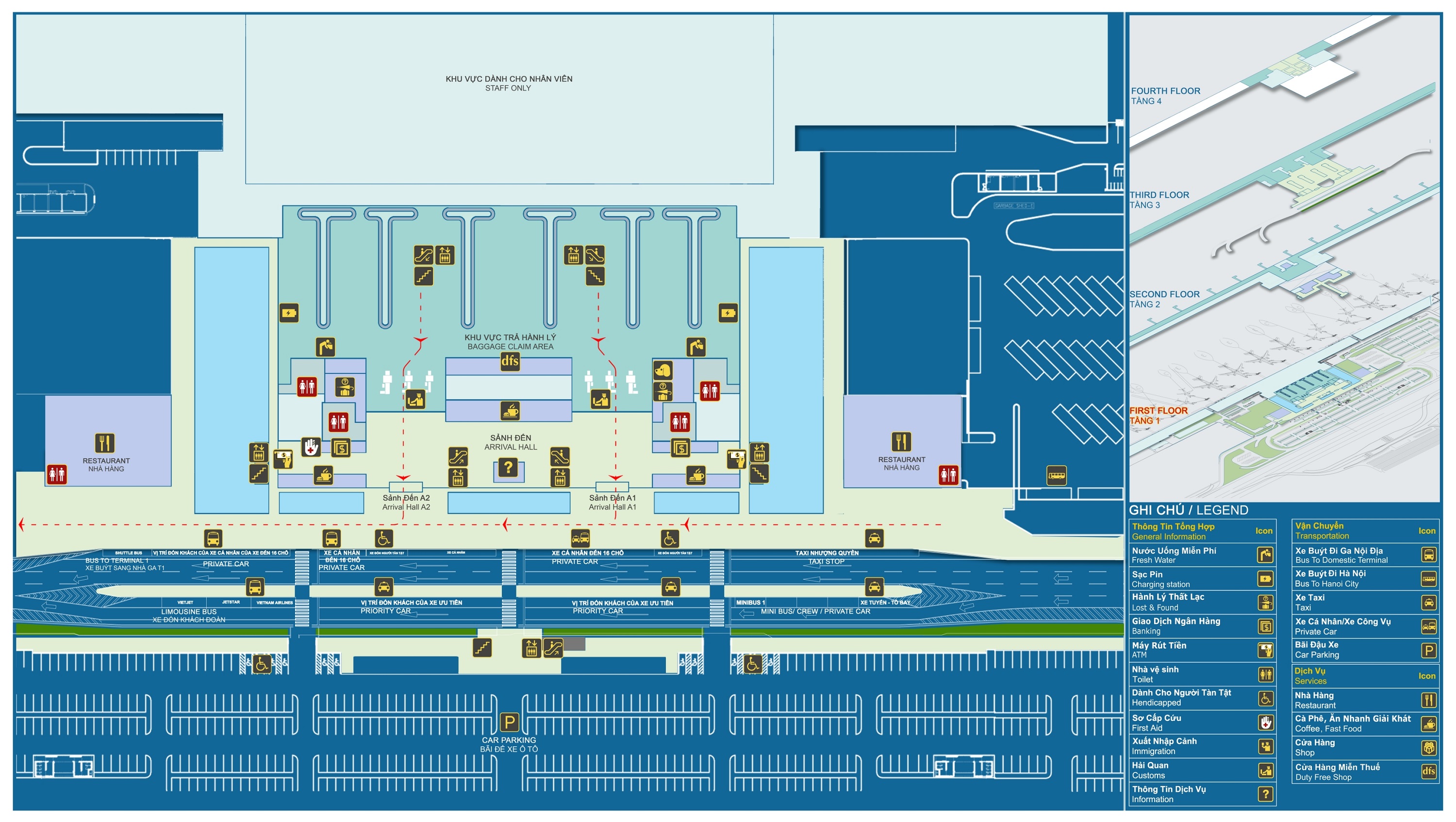

Terminal T2 of Noi Bai Airport spans an area of 139,216 square meters. It can handle up to 10 million passengers each year. The building boasts a modern design that is in harmony with nature. With an initial investment of 18,000 billion VND, it is fully equipped with the latest and most advanced technological systems. The layout of Terminal 2 is as follows:
– First floor: International Arrival Hall
– Second floor: Immigration and Customs procedures for Transit and International Arrivals
– Third floor: International Departure Hall
– Fourth floor: Lounge for Business Class and Commercial Air Services
4. What are the utility services of Hanoi International Airport?
Noi Bai Airport provides various ground services to cater to the needs of passengers. Some of them include:
- ATM service: ATMs are located in the lobby area on the first floor of Terminal 1 and the east and west wings of Terminal 2.
- Free trolley service: Trolleys can be found on the second floor of Lobby A, B, and E of Terminal 1, and the departure and arrival lounges of Terminal 2.
- Luggage packing service: Available on the second floor of Lobby A, B, and E of Terminal 1 and the lobby area on the third floor of Terminal 2.
- Free battery charging service: Available in the lobby areas of both terminals, including Terminal 1’s Lobby A-E and the departure lounge on the second floor, and Terminal 2’s lobby on the third floor and the departure lounge.
- Food: Passengers can find various food stalls in both terminals, the lobby, and departure lounges.
- Sleeping pods: These pods are 4 square meters large and located on the second and third floors of Terminal 1 and the second floor of Terminal 2. They are suitable for passengers to take a nap for early morning Noi Bai International Airport departures, long transfers, or unexpected delays.
- Noi Bai International Airport shops: Shops selling souvenirs and Vietnamese specialties, handicrafts, textiles, cosmetics, and accessories can be found in the departure lounges of both terminals.
- Other services include Noi Bai International Airport duty free shops, locker rooms, and more.
5. Information of Check-in Procedures at Noi Bai Airport:
To ensure a smooth and stress-free check-in experience at Noi Bai Airport, here are some important things to keep in mind:
For International Flights:
- International passengers should arrive at the airport at least 3 hours before their scheduled flight departure time to make sufficient time for check-in, immigration, and security procedures.
- Passengers are required to show a valid passport, visa (if required), and boarding pass at the check-in counter.
- Luggage allowance and weight restrictions may vary depending on the airline and ticket class, so it is important to check with the airline beforehand.
- Excess baggage fees may apply for passengers who exceed the allowed luggage limit.
- After checking in, passengers should proceed to immigration for passport control and security screening before proceeding to the departure lounge.
- Security screening procedures may include a scan of hand luggage, personal items, and body search.
- Passengers with disabilities or special needs should inform the airline or airport in advance to arrange for assistance.
For Domestic Flights:
- Check-in counters usually open 2 hours before the scheduled departure time and close 45 minutes before departure.
- Passengers are required to bring a valid ID card and a ticket to check in.
- Passengers can check in at the counters provided by the airline, either manually or through self-service kiosks.
- Luggage must be checked in before the cut-off time, and the maximum weight allowed for checked-in luggage varies by airline.
- For online check-in, passengers must have a printed boarding pass or a digital one on their mobile device.
- After checking in, passengers must proceed to security checks before proceeding to the departure lounge.
6. Transportation in Hanoi International Airport:
Various transportation services, including public taxis, minibus and public buses, are available to Hanoi Noi Bai Airport arrivals level. You can also go Noi Bai Airport to/from Halong Bay. Book transfers to and from Hanoi Noi Bai International Airport (HAN), grab taxis, vans, and executive cars through our search engine, it’s easy and fast to use!















